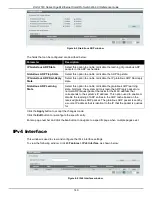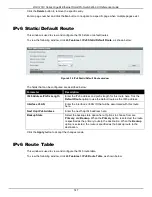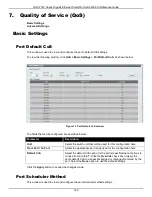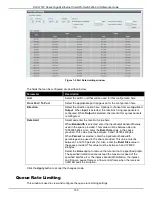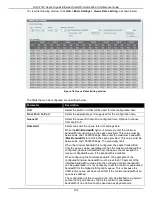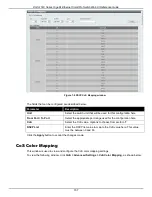
DGS-1510 Series Gigabit Ethernet SmartPro Switch Web UI Reference Guide
142
Mask
Enter the IPv6 subnet mask for this interface here.
Secondary
Tick the check box to use the IPv4 address and mask as the
secondary interface configuration.
Click the
Apply
button to accept the changes made.
Click the
Delete
button to remove the specific entry.
Enter a page number and click the
Go
button to navigate to a specific page when multiple pages exist.
After clicking the
DHCP Client
tab, the following page will appear.
Figure 6-8 DHCP Client window
The fields that can be configured are described below:
Parameter
Description
DHCP Client Client-ID
Enter the VLAN interface, whose hexadecimal MAC address will be
used as the client ID to be sent with the discover message.
Class ID String
Enter the vendor class identifier with the maximum of 32 characters.
Tick the
Hex
check box to have the class identifier in the hexadecimal
form.
Host Name
Enter the host name. The maximum length is 64 characters. The host
name must start with a letter, end with a letter or digit, and only with
interior characters letters, digits, and hyphens.
Lease
Specify the preferred lease time for the IP address to request from the
DHCP server. Enter the day duration of the lease, or select the hour
and minute duration of the lease.
Click the
Apply
button to accept the changes made.
IPv4 Static/Default Route
This window is used to view and configure the IPv4 static and default route settings. The Switch supports
static routing for IPv4 formatted addressing. Users can create up to 64 static route entries for IPv4. For
IPv4 static routes, once a static route has been set, the Switch will send an ARP request packet to the
next hop router that has been set by the user. Once an ARP response has been retrieved by the Switch
from that next hop, the route becomes enabled. However, if the ARP entry already exists, an ARP
request will not be sent.
The Switch also supports a floating static route, which means that the user may create an alternative
static route to a different next hop. This secondary next hop device route is considered as a backup static
route for when the primary static route is down. If the primary route is lost, the backup route will uplink and
its status will become active.
Entries into the Switch’s forwarding table can be made using both an IP address subnet mask and a
gateway.
Содержание DGS-1510 Series
Страница 1: ...1...













